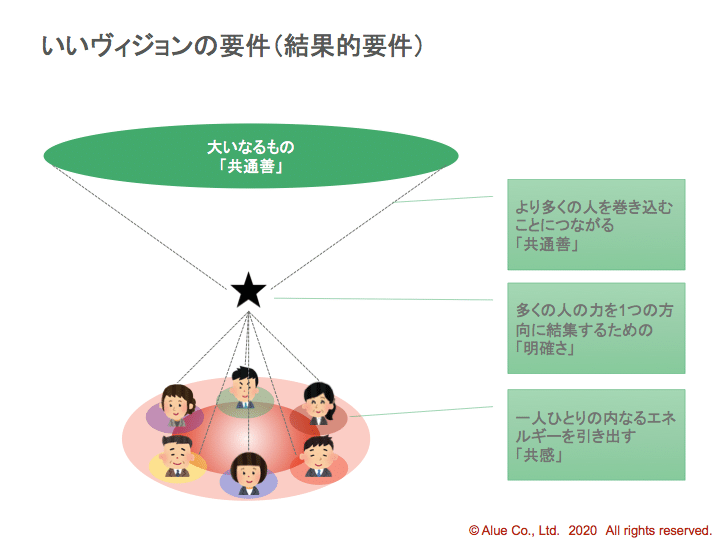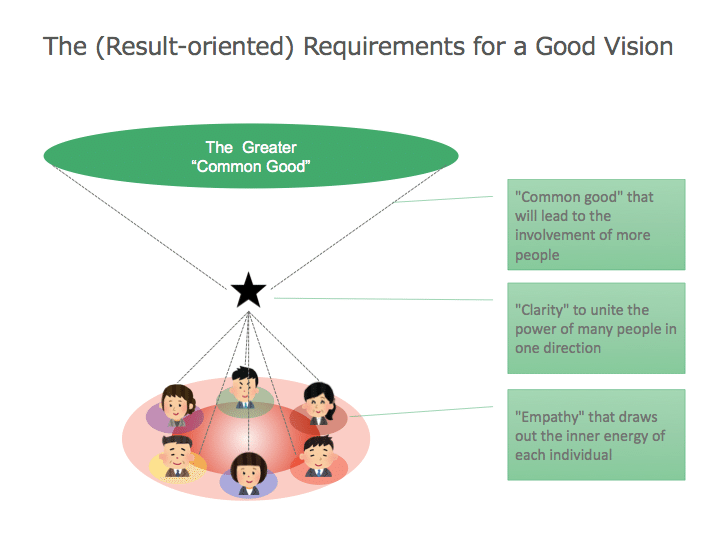
なぜ、「いいヴィジョンは明確である」だけでは不十分なのか?
前回の記事では、いいヴィジョンの3つめの要件として、いいヴィジョンは意識の変容を含意していることについてお話しました。今回の記事では、これまでお話ししてきた、いいヴィジョンの要件をまとめた上で、「一般的に言われているいいヴィジョンの要件」との違いについて考えたいと思います。
これまでの記事で取り上げてきた、いいヴィジョンの3つの要件を確認しましょう。
いいヴィジョンの(原因的)要件
▼【主体的真理とのつながり】自分の、そして、チームメンバーの主体的真理とつながっており、内なるエネルギーが引き出されている
▼【野心ではなく志】自分のためだけ(野心)ではなく、自分を含めた周囲の人のため(志)になっている。そして、内なるエネルギーと志が両立している
▼【意識の変容を伴う】現象面の変化だけではなく、意識の変容を含意している
意識の意識化の観点から、いいヴィジョンを構想するための要件は、この3つのみとなります。ここで、「一般的に言われているいいヴィジョンの要件とは違うな」という印象を持たれた方もいらっしゃるのではないでしょうか。
例えば、一般的には、いいヴィジョンの要件として「明確であること」ということが挙げられます。これも正しい見解だと思います。それでは、一般的に言われているヴィジョンの要件と、上記の要件は何が違うのでしょうか?
結論から言えば、上記の要件は「原因的要件」であり、一般的に言われている要件は「結果的要件」である(ことが多い)、ということです。
いい悪いという議論ではありません。どちらもいいヴィジョンの要件であることには変わりありません。ただし、結果的要件だけだと「結果的にそうなっている」ということを記述しているだけなので「では、どうすればいいヴィジョンが描けるのか」という問いに対して答えることができないという限界があります。

これまでの記事で、いいヴィジョンの要件を「原因的要件」、すなわち、「意識しようと思えば意識できる、実践できる要件」に絞ってきたのは、「では、どうすればいいヴィジョンが描けるのか」という問いに答えるためでした。
ここで、いいヴィジョンの「結果的要件」についてまとめた上で、「原因的要件」とのつながりについて考察していきましょう。
いいヴィジョンの(結果的)要件
前回の記事でも挙げましたが、いいヴィジョンあるいは、いいミッションと言われる事例をもう一度見てみましょう。
いつの日か、私の4人の子供たちが、肌の色で判断されるのではなく、人格の中身で判断されるような国に住むという夢があります。
(米国の公民権運動の指導者 マーティン・ルーサー・キング・ジュニア)
「Google の使命は、世界中の情報を整理し、世界中の人がアクセスできて使えるようにすることです」
(Google社)
「包括的な金融サービスを提供することで、貧困に苦しむ人々が自らの可能性を実現し、貧困の悪循環から抜け出すことができるようにします」
(グラミン銀行)
これらの事例にも見事に当てはまりますが、一般的に言われているいいヴィジョンの(結果的)要件としては次のようなものが挙げられます。
いいヴィジョンの(結果的)要件
▼【明確さ】将来の姿が、3次元の立体的なイメージとしてありありと想像できる
▼【共通善】実現すると多くの人の幸せにつながるイメージが湧く
▼【共感】ヴィジョンに共感し、「自分ごと」と思える
「明確さ」は、いいヴィジョンの要件としてよく挙げられるポイントです。いいヴィジョンは、言語的な明快であるということにとどまらず、ありありとした3次元の立体的なイメージを湧かせます。これによって、関わる人々が共通の未来イメージをもつことができ、力を結集することにつながります。
「共通善」というのは、多くの人が「いい」と思えるような「大きな目的」を包含しているということです。実現することで、多くの人の幸せに繋がるイメージが湧くことで、多くの人の共感と協力を得ることができます。
「共感」というのは、一人ひとりがヴィジョンに共感することで、そのヴィジョンを「自分事」であると捉えることができるようになり、その人の内なるエネルギーを引き出すことができます。

そして、この3つの要素が相互補完的な関係になっていて、この全てが揃うことで、変革を推進するような大きなインパクトをもたらすヴィジョンになっています。
▼多くの人の力を1つの方向に結集するための「明確さ」
・・・これがないと、多くの人が集まっても、成し遂げたいイメージがバラバラになってしまい、力を結集できないかもしれない
▼より多くの人を巻き込むことにつながる「共通善」
・・・これがないと、一部の人を巻き込むことができても、多くの人を巻き込むことができないかもしれない
▼一人ひとりの内なるエネルギーを引き出す「共感」
・・・これがないと、総論賛成であっても、変革を前に進めていくような力強いエネルギーを引き出すことができないかもしれない
なぜ、結果的要件だけでは不十分なのか?
しかし、先ほど述べたように、これらの3つの要素は、確かにいいヴィジョンの要件ではあるものの、「結果的に」そのような要件が成立しているという感じがして、どのようにすればいいヴィジョンを設定することができるのかということについて多くを語ることができません。
これらの「ヴィジョンの結果的要件」は「ヴィジョンの原因的要件」が充足されることによって、自然と満たされるという関係になっています。自動的に満たされるほどの一致感ではありませんが、原因的要件を充足させることができれば、結果的要件を満たすことはさほど難しいことではありません。
では、それぞれの結果的要件が、3つの原因的要件とどのような関係になっているかについて確認していきましょう。
「明確さ」という要件については、「何か元となるイメージやエネルギーがある」からこそ、それを明確に描くということができます。「明確さ」が最初にあるのではなく、「元となるイメージやエネルギー」が最初にあります。
「共通善」という要件については、多くの人に共通する目的を掲げれば良いのかといえばそうではありません。共通善としてのヴィジョンを掲げていても、どこかお題目になってしまっているケースがあります。それは、前回の記事でお伝えしたような「内なるエネルギー」とのつながりが欠けていることが多いです。「内なるエネルギーと志」が両立していることが根源的には重要です。
「共感」という要件については、「内なるエネルギー」があること、「野心ではなく志」であること、そして、「意識の変容を伴う」ことの合わせ技によって、生まれてくるものです。「内なるエネルギー」からくる熱量が、人に影響を与えます。そして、「野心ではなく志」であることによって、その熱量が人を動かします。
これに加えて、「意識の変容を伴う」ことによって、一人ひとりの主体的真理との重ね合わせができる広がりや奥行きをもつことができます。現象の原因となっている意識の変容を伴っているため、結果的に現れると想定される事象に広がりがあり、一人ひとりの主体的真理との接点を見出しやすいのです。
このことによって、熱量が人を動かすだけではなく、熱量がその人の主体的真理に共鳴して、「自分ごと」となります。人の熱量によって動かされるというフォロワーシップから、自分の熱量によって人を動かしていくリーダーシップに変わっていきます。

原因的要件は、いつでも「取り組み始めることができる」
ここまで原因的要件が結果的要件にどのようにつながっているのかを見てきました。
原因的要件に今一度を目を向けてみると、その全てが「意識」に関わることであり、その「意識」というのは、全ての起点として「いつでも取り組み始めることができる」ことであることにお気づきいただけるのではないでしょうか。
これまでも何度かお伝えしていることではありますが、意識は現象の根源です。
現象
↓
現象の構造・背景
↓
行動
↓
決断
↓
思考・感情
↓
メンタルモデル(信念体系)
↓
直感(主体的真理)
↓
自己(自意識の主体)
意識レベルでヴィジョンと捉えるということは、上図の下の方から上の方に向かっていくようなイメージです。現象レベルでヴィジョンを捉えるのではなく、意識レベルでヴィジョンを捉えることによって、いつでも「取り組み始めることができる」ものであり、共感・共鳴を生むインパクトを生み出し得るものになります。
既にあるヴィジョンが、いいヴィジョンかそうではないかを見極めるためだけであれば、いいヴィジョンの結果的要件に注目すれば良いと思います。
しかし、いいヴィジョンを創り出すため、あるいは、既にあるヴィジョンを再解釈したり再設定したりするためには、原因的要件から始めることをお勧めします。原因的要件を満たすようにヴィジョンを創っていき、あるいは、再解釈していき、その後で結果的要件を満たすように表現するというイメージです。

これまで、いいヴィジョンの要件について、結果的要件と原因的要件に分けて考察してきました。最後に、これまでの内容をまとめておきましょう。
いいヴィジョンの原因的要件
▼【主体的真理とのつながり】自分の、そして、チームメンバーの主体的真理とつながっており、内なるエネルギーが引き出されている
▼【野心ではなく志】自分のためだけ(野心)ではなく、自分を含めた周囲の人のため(志)になっている。そして、内なるエネルギーと志が両立している
▼【意識の変容を伴う】現象面の変化だけではなく、意識の変容を含意している
いいヴィジョンの結果的要件
▼【明確さ】将来の姿が、3次元の立体的なイメージとしてありありと想像できる
▼【共通善】実現すると多くの人の幸せにつながるイメージが湧く
▼【共感】ヴィジョンに共感し、「自分ごと」と思える
本日の問いとなります。(よろしければ、コメントにご意見ください)
・あなたがいいヴィジョンだと思うものを1つ想定してください。そのヴィジョンには、どのように「いいヴィジョンの結果的要件」を満たしているでしょうか?
・そのヴィジョンは、どのように「いいヴィジョンの原因的要件」を満たしていそうでしょうか?その原因的要件と結果的要件は、どのようなつながりがありそうでしょうか?
Why is it not enough to say, "A good vision is clear"?
In my last article, I talked about the third requirement of a good vision, which is that it implies a transformative change in consciousness. In this article, I would like to summarize the requirements for good visions that I have discussed so far, and then consider the differences between them and the "commonly accepted requirements for good visions."
Let's review the three requirements of a good vision that we have discussed in previous articles.
The (Cause-oriented) Requirements for a Good Vision
・Connectedness with the subjective truth: Connectedness with the subjective truth of oneself and team members, drawing out their inner energy.
・Not ambition, but KOKOROZASHI: Not just for oneself (ambition), but for others including oneself (KOKOROZASHI). And inner energy and KOKOROZASHI are compatible.
・Implications of a transformative change in consciousness: This implies not only a change in phenomena, but also a transformative change in consciousness.
From the perspective of ISHIKI(Consciousness) Management, there are only three requirements for envisioning a good vision. At this point, some of you may have the impression that this is different from the commonly accepted requirements for a good vision.
For example, one of the commonly accepted requirements for a good vision is that it should be clear. I think this is also a correct view. So what is the difference between the general requirement of vision and the above requirement?
The conclusion is that the above requirements are "cause-oriented requirements", and the requirements that are commonly referred to are (often) "result-oriented requirements".
This is not a discussion of good and bad. Both are requirements for good visions. However, if we use only the result-oriented requirements, we cannot answer the question, "Then how can we create a good vision?"
In the previous articles, I have focused on cause-oriented requirements, that is, requirements that we can be aware of and practice if we want to, to answer the question, "Then how can we have a good vision?"
Here, let's summarize the "result-oriented requirements" of a good vision, and then discuss the connection with the "cause-oriented requirements".
The (result-oriented) requirements of a good vision
As I mentioned in my previous article, let's take another look at the examples of good visions or good missions.
"I have a dream that one day this nation will rise up and live out the true meaning of its creed: "We hold these truths to be self-evident, that all men are created equal."
(Martin Luther King, Jr.)
"Our mission is to organise the world’s information and make it universally accessible and useful."
(Google)
"By providing comprehensive financial services, empowering the poor to realize their potential and break out of the vicious cycle of poverty."
(Grameen Bank)
The following are some of the ( result-oriented) requirements of a good vision that are commonly mentioned, which apply beautifully to these cases above.
The (Result-oriented) Requirements for a Good Vision
・Clarity: A three-dimensional, dynamic image of the future can be imagined.
・Common good: An image that, when realized, will lead to the happiness of many people.
・Empathy: To be able to relate to the vision and think of it as one's own.
"Clarity" is one of the most common requirements for a good vision. A good vision is not only linguistically clear, but it also evokes a vivid three-dimensional image. This allows the people involved to have a common image of the future, which leads to the collective power of the people.
The "common good" encompasses a "greater purpose" that many people would consider "good". By creating an image that, when realized, will lead to the happiness of many people, we can gain the sympathy and cooperation of many people.
"Empathy" means that when each person empathizes with the vision, he or she is able to see the vision as his or her own, and draws out the energy within him or her.

And these three elements are complementary to each other, and when all of them come together, they form a vision that will have a significant impact that will drive change.
▼"Clarity" to unite the power of many people in one direction
...Without this, even if many people get together, they may not be able to unite their power because they may have different images of what they want to accomplish.
▼ "Common good" that will lead to the involvement of more people.
...Without this, we may be able to involve some people, but we may not be able to involve many people.
▼"Empathy" that draws out the inner energy of each individual
...Without this, even if we generally agree, we may not be able to draw out the powerful energy that will drive the change forward.
Why is result-oriented requirements not enough?
However, as I mentioned earlier, although these three elements are indeed requirements for a good vision, I feel that such requirements are established "as a result" and cannot say much about how to set up a good vision.
These "result-oriented requirements of vision" are naturally fulfilled when the "cause-oriented requirements of vision" are fulfilled. It's not so unanimous that they are automatically fulfilled, but if you can fulfill the causal requirements, it's not so difficult to fulfill the result-oriented requirements.
Now let's see how each of the result-oriented requirements relates to the three causal-oriented requirements.
As for the requirement of "clarity," it is because there is some original image or energy that we can draw it clearly. Clarity doesn't come first; the original image or energy comes first.
As for the requirement of "common good," it is not enough to have a common goal that is shared by many people. In some cases, even if we have a vision of the common good, it might be just an agenda. This is often due to a lack of connection with the "inner energy" as I mentioned in my previous article. It is fundamentally important to have both "inner energy and KOKOROZASHI(aspiration)".
As for the requirement of empathy, it comes from a combination of inner energy, aspiration rather than ambition, and transformative changes in consciousness. The amount of passion that comes from "inner energy" influences people. And by being "KOKOROZASHI(aspirational), not ambitious," that passion will move people.
In addition to this, "accompanied by the transformative change of consciousness," it is possible to have a breadth and depth that can be overlapped with the subjective truth of each individual. Because it is accompanied by a transformation of consciousness, which is the cause of the phenomena, the events that are expected to appear as a result have a wider scope, and it is easier to find a connection with the subjective truth of each individual.
By doing this, not only does the passion move the person, but the passion resonates with the person's subjective truth and becomes their own matter. From followership, where one is moved by the passion of others, it changes to leadership, where one moves others with one's own passion.
Cause-oriented requirements can begin to be addressed at any time
We have seen how cause-oriented requirements are connected to result-oriented requirements.
If you look again at the causal requirements, you will notice that all of them are related to "consciousness" which, as the starting point for everything, can be "started at any time".
As I have mentioned several times in the past, consciousness is the root of phenomena.
Phenomenon
↓
Structure and background of the phenomenon
↓
Behavior
↓
Decision
↓
Thoughts and feelings
↓
Mental models (Belief systems)
↓
Intuition (Subjective truth)
↓
Self (The subject of self-consciousness)
Perceiving a vision at the level of consciousness is like moving from the bottom of the diagram above to the top. By perceiving visions at the level of consciousness, rather than at the level of phenomena, we can "start working on them" at any time, and they can create an impact that generates empathy and resonance.
If we only want to determine whether a vision we already have is a good vision or not, we can simply focus on the result-oriented requirements of a good vision.
However, in order to create a good vision, or to reinterpret or reconfigure an existing vision, it is recommended to start with the cause-oriented requirements. It is recommended to create or reinterpret a vision so that it meets the cause-oriented requirements, and then express it so that it meets the result-oriented requirements.
So far, we have discussed the requirements for good vision, dividing them into cause-oriented and result-oriented requirements. Finally, let's summarize what we have discussed so far.
The (Cause-oriented) Requirements for a Good Vision
・Connectedness with the subjective truth: Connectedness with the subjective truth of oneself and team members, drawing out their inner energy.
・Not ambition, but KOKOROZASHI: Not just for oneself (ambition), but for others including oneself (KOKOROZASHI). And inner energy and KOKOROZASHI are compatible.
・Implications of a transformative change in consciousness: This implies not only a change in phenomena, but also a transformative change in consciousness.
The (Result-oriented) Requirements for a Good Vision
・Clarity: A three-dimensional, dynamic image of the future can be imagined.
・Common good: An image that, when realized, will lead to the happiness of many people.
・Empathy: To be able to relate to the vision and think of it as one's own.
Here are the quests of the day. (If you'd like, please share your thoughts in the comments.)
・Assume one thing that you think is a good vision. How does that vision meet the "result-oriented requirements of a good vision"?
・How is the vision likely to meet the cause-oriented requirements of a good vision? What are the connections between the cause-oriented and result-oriented requirements?
Bunshiro Ochiai
この記事が気に入ったらサポートをしてみませんか?
